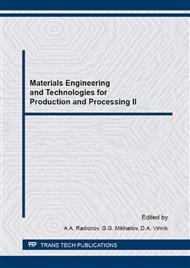[1]
B.S. Huanga, W.F. Yinb, D.H. Sangc, Z.Y. Jianga, Synergy effect of naphthenic acid corrosion and sulfur corrosion in crude oil distillation unit, Applied Surface Science. 259 (2012) 664-670.
DOI: 10.1016/j.apsusc.2012.07.094
Google Scholar
[2]
A.D. Berkowitz, M.A. Squires, Dealing with Sulfur in Residual Fuel Oil, Power Generation and Environmental Change, MIT Press. 1 (2003) 228-245.
Google Scholar
[3]
V.D. Zinin, Prospects of production of ecologically pure diesel fuel at domestic refineries, 2010, pp.42-45.
Google Scholar
[4]
E.R. Magaril, Influence of quality of motor fuels on the operational and environmental performance cars, KDU, (2008).
Google Scholar
[5]
R.S. Fakhrutdinov, R.D. Ermakov, R.B. Fakhrutdinov, N.A. Terentieva, I.N. Derow, L.K. Khvatova, RU Patent 2235807. (2004).
Google Scholar
[6]
M.W. Kadyrov, S.V. Krupin, V.P. Barabanov, RU Patent 2171826. (2001).
Google Scholar
[7]
Y.O. Kolpakov, I.K. Novikov, M.I. Spiridonov, V.S. Kolpakova, V.A. Rak, A.A. Anufriev, RU Patent 2394874. (2010).
Google Scholar
[8]
N.N. Darwish, I.A. Zubaidi, Y.E. Sayed, Z. Shareefdeen, Factorial design analysis for adsorption of sulfur compounds from diesel oil on activated charcoal, Modeling, Simulation, and Applied Optimization (ICMSAO), in: Proceeding of 2015 6th International Conference, Istanbul. (2015).
DOI: 10.1109/icmsao.2015.7152231
Google Scholar
[9]
K.V. Lebedinsky, Improvement of technology of hydrodynamic cavitation cleaning of components from oil contamination, Ph.D. diss., Penza, (2012).
Google Scholar
[10]
I.M. Fedotkin, Cavitation: The use of cavitation in the industry (physical effects at cavitation, the cavitation devices and their uses), Arcturus, (1998).
Google Scholar
[11]
J. Jianbing, W. Jianli, L. Yongchao, Y. Yunliang, X. Zhichao, Preparation of biodiesel with the help of ultrasonic and hydrodynamic cavitation, Ultrasonics. 44 (2006) 411-414.
Google Scholar
[12]
A.G. Chakinalaa, P.R. Gogateb, A.E. Burgessa, D.H. Bremnera, Industrial wastewater treatment using hydrodynamic cavitation and heterogeneous advanced Fenton processing, Chemical Engineering Journal. 2-3 (2009) 498-502.
DOI: 10.1016/j.cej.2009.05.018
Google Scholar
[13]
R. Knapp, Cavitation, Mir, Moscow, (1974).
Google Scholar
[14]
M.A. Promtov, Pulse technology for refining and petrochemicals, CSIITEOILCHEM. 6 (2007) 22-24.
Google Scholar
[15]
T. Boczar, D. Zmarzly, M. Szmechta, The intensity of acoustic cavitation noise in thermally aged insulating oils, Electrical Insulating Materials (ISEIM), in: Proceedings of 2011 International Conference, Kyoto. (2011) 499-502.
DOI: 10.1109/iseim.2011.6826322
Google Scholar
[16]
A.A. Pliss, Influence of ultrasound on physicochemical properties of oil, The interval, (2007).
Google Scholar
[17]
M.S. Mullochaev, Investigation of the effect of ultrasonic treatment and chemical reagents on rheological properties of viscous oils, Equipment and technologies for oil and gas industry. (2010) 31-34.
Google Scholar
[18]
H. Mei, B. W Mei, T. Fu Yen, A new method for obtaining ultra-low sulfur diesel fuel via ultrasound assisted oxidative desulfurization, Fuel. 4 (2003) 405-414.
DOI: 10.1016/s0016-2361(02)00318-6
Google Scholar
[19]
A.E. Brandt, Hydrodynamic cavitation treatment as a way to reduce the viscosity of high-viscosity oil and increase the efficiency of transport, Part 3, Academy of natural Sciences, (2015).
Google Scholar
[20]
M.A. Tarasenko, Reduction of oil viscosity by the method of hydrodynamic, in: Proceedings of the XV Intern. Scientific practical Conf.: Natural and intellectual resources of Siberia, Sibresurs 2014. (2014) 44-45.
Google Scholar
[21]
D.D. Logvinenko, Intensification of technological processes in apparatus with a vortex layer, Technology, (1976).
Google Scholar
[22]
I.G. Volodin, Electromagnetic processes in devices with arbitrary moving part, Dr. diss., Novocherkassk, (2009).
Google Scholar
[23]
A.Y. Bakhvalov, Electromechanical device with selectable secondary part: algorithms of analysis and synthesis and advanced designs, Ph.D. diss., Novocherkassk, (2008).
Google Scholar
[24]
A.V. Pavlenko, Modeling the dynamics of neutral high-speed actuation of the electromagnet, News of higher educational institutions: Electromechanics. (1998) 40-42.
Google Scholar


